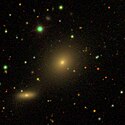NGC 7206
| Galaxie NGC 7206 | |
|---|---|
 | |
| SDSS-Aufnahme | |
| AladinLite | |
| Sternbild | Pegasus |
| Position Äquinoktium: J2000.0, Epoche: J2000.0 | |
| Rektaszension | 22h 05m 40,9s[1] |
| Deklination | +16° 47′ 07″[1] |
| Erscheinungsbild | |
| Morphologischer Typ | S0[1][2] |
| Helligkeit (visuell) | 13,4 mag[2] |
| Helligkeit (B-Band) | 14,4 mag[2] |
| Winkelausdehnung | 1,0' × 0,7'[2] |
| Positionswinkel | 147°[2] |
| Flächenhelligkeit | 12,9 mag/arcmin²[2] |
| Physikalische Daten | |
| Rotverschiebung | 0.031488 ± 0.000103[1] |
| Radialgeschwindigkeit | (9440 ± 31) km/s[1] |
| Hubbledistanz vrad / H0 | (430 ± 30) · 106 Lj (131,9 ± 9,2) Mpc [1] |
| Geschichte | |
| Entdeckung | Albert Marth |
| Entdeckungsdatum | 7. August 1864 |
| Katalogbezeichnungen | |
| NGC 7206 • UGC 11904 • PGC 68127 • CGCG 451-006 • MCG +03-56-007 • 2MASX J22054089+1647067 • | |
NGC 7206 ist eine linsenförmige Galaxie vom Hubble-Typ S0 im Sternbild Pegasus. Sie ist schätzungsweise 430 Millionen Lichtjahre von der Milchstraße entfernt.
Das Objekt wurde am 7. August 1864 von Albert Marth entdeckt.[3]
Weblinks
Einzelnachweise
Auf dieser Seite verwendete Medien
Autor/Urheber: Sloan Digital Sky Survey, Lizenz: CC BY 4.0
The sky image is obtained by Sloan Digital Sky Survey, DR14 with SciServer.
Angle of view: 4' × 4' (0.3" per pixel), north is up.
Details on the image processing pipeline: https://www.sdss.org/dr14/imaging/jpg-images-on-skyserver/
